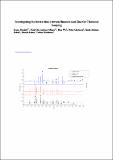Por favor, use este identificador para citar o enlazar a este item:
http://hdl.handle.net/10261/311035COMPARTIR / EXPORTAR:
 SHARE SHARE
 CORE
BASE CORE
BASE
|
|
| Visualizar otros formatos: MARC | Dublin Core | RDF | ORE | MODS | METS | DIDL | DATACITE | |

| Título: | Investigating the interaction between ilmenite and zinc for chemical looping |
Autor: | Stanicic, Ivana; Lidman Olsson, Emil Ola; Hao, Wu; Glarborg, Peter; Adánez-Rubio, Iñaki CSIC ORCID; Leion, Henrik; Mattisson, Tobias | Palabras clave: | Ilmenite Zinc Chemical Looping Combustion Oxygen carrier |
Fecha de publicación: | 18-may-2023 | Editor: | ACS Publications | Citación: | Energy and Fuels 37(11): 7856-7870 (2023) | Resumen: | The iron and titanium oxide ilmenite is a benchmark oxygen carrier for chemical looping combustion (CLC) and oxygen carrier-aided combustion (OCAC). Both of them are combustion technologies for biomass and waste fuels with lower emissions and low costs for carbon capture. Here, the interaction between the ash component zinc and oxygen carrier ilmenite is studied in a two-staged vertical tube reactor. Three types of ilmenites─Norwegian rock ilmenite, synthesized ilmenite, and ilmenite extracted after 200 h of OCAC in a full-scale fluidized bed unit─were exposed to gas-phase Zn and ZnCl2. Following the exposure, samples were analyzed concerning morphology, chemical distribution, composition, and crystalline phases. The observations were complemented with thermodynamic equilibrium calculations. It is observed that the iron-rich layer formed on the external surface of rock ilmenite after activation promotes the reaction with both gaseous zinc compounds, with zinc ferrite formed in the external Fe-rich layer. In contrast, ilmenite with no segregation of Fe and Ti showed to interact less with zinc species. Metallic Zn penetrated the particles, while the interaction depth was shallow with ZnCl2 for all investigated ilmenite oxygen carriers. The gaseous conditions, particle ash layer composition, and iron availability are shown to play an important role in the interaction between zinc compounds and ilmenite particles. Based on these results, interaction mechanisms for Zn and ZnCl2 are proposed. This interaction could have environmental implications for the toxicity of ash streams from waste combustion in addition to possibilities for Zn recycling. | Descripción: | 16 figures, 2 tables.-- Supporting information available. | Versión del editor: | http://dx.doi.org/10.1021/acs.energyfuels.3c01052 | URI: | http://hdl.handle.net/10261/311035 | DOI: | 10.1021/acs.energyfuels.3c01052 | ISSN: | 0887-0624 | E-ISSN: | 1520-5029 |
| Aparece en las colecciones: | (ICB) Artículos |
Ficheros en este ítem:
| Fichero | Descripción | Tamaño | Formato | |
|---|---|---|---|---|
| acs.energyfuels.3c01052.pdf | Artículo principal | 4,55 MB | Adobe PDF |  Visualizar/Abrir |
| ef3c01052_si_001.pdf | Información suplementaria | 2,94 MB | Adobe PDF |  Visualizar/Abrir |
CORE Recommender
SCOPUSTM
Citations
2
checked on 11-may-2024
WEB OF SCIENCETM
Citations
1
checked on 26-feb-2024
Page view(s)
43
checked on 13-may-2024
Download(s)
25
checked on 13-may-2024
Google ScholarTM
Check
Altmetric
Altmetric
Este item está licenciado bajo una Licencia Creative Commons



